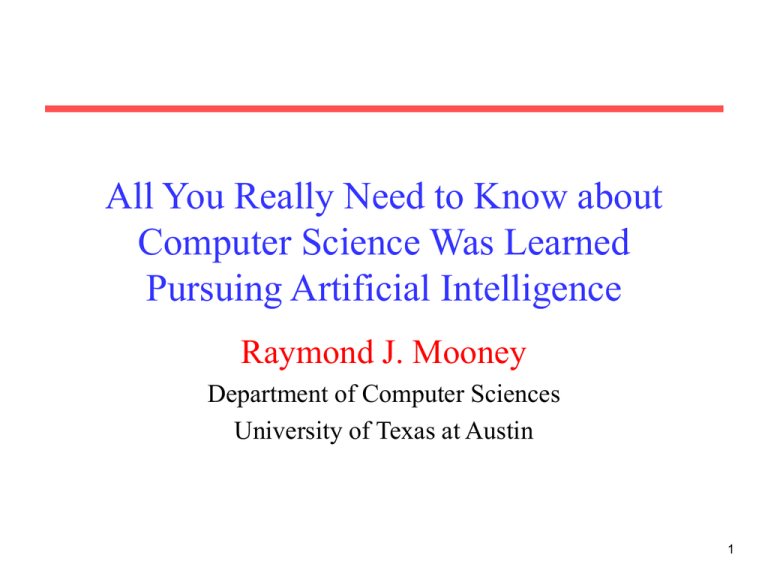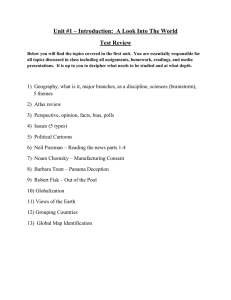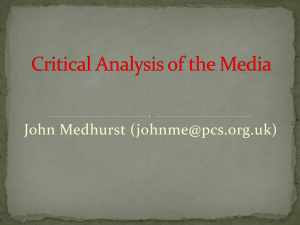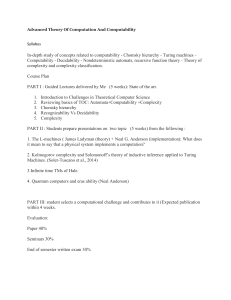All You Really Need to Know about Computer Science Was Learned
advertisement

All You Really Need to Know about Computer Science Was Learned Pursuing Artificial Intelligence Raymond J. Mooney Department of Computer Sciences University of Texas at Austin 1 Source of the Exaggerated Title 2 History of Computing Concepts • Most of the fundamental concepts in computing were developed by people who were trying to understand, emulate, or augment the human mind. – – – – – – – Boolean logic Finite state machines Formal grammars Turing machines Linked lists Recursion Garbage collection – Combinatorial search – Automatic theorem proving – Time shared OS – Computer networks – GUI’s – Complexity theory 3 Origins of CS in the “Soft” Sciences • There is a general perception that CS was developed by electrical engineers, mathematicians, physicists, and others from the “hard sciences”. • Actually, many fundamental CS concepts were introduced by neurobiologists, psychologists, linguists and others from the “soft sciences.” 4 AI & CS A Strained Relationship • AI is fairly isolated from the CS mainstream. – AAAI is an independent society, unattached to ACM or IEEE with which most other CS associations are affiliated. – SIGART is a weak organization with little influence. – AI is never included in the Federated Computing Research Conference. • Previous NSF administrators tried to marginalize AI. • Many CS faculty in other areas have an unfavorable view of AI. • Frequently AI seems to be the “crazy aunt” of CS that some believe must be locked up in attic of the ivory tower. 5 Boolean Logic • George Boole’s 1854 book is entitled: “The Laws of Thought” • Boole was motivated by a desire to understand and formalize human reasoning. • The first sentence reads: – “The design of the following treatise is to investigate the fundamental laws of those operations of the mind by which reasoning is performed;…; and finally, to collect from the various elements of truth brought to view in the course of these inquiries some probable intimations concerning the nature and constitution of the human mind.” 6 From Boole to Shannon • Claude Shannon (of information theory fame) was the first to apply Boolean algebra to computing hardware in his 1937 M.S. Thesis “A Symbolic Analysis of Relay and Switching Circuits.” • Shannon also had interest in AI and published the first paper on computer chess in his 1950 Scientific American article “A Chess-Playing Machine.” 7 Turing Machine • Introduced in Alan Turing’s 1936 paper “On Computable Numbers, With an Application to the Entscheidungsproblem,” • Turing clearly conceived of his machine as simulating the thinking of a human “computer” – “We may compare a man in the process of computing a real number to a machine which is only capable of a finite number of conditions…” – “The behavior of the computer at any moment is determined by the symbols which he is observing, and his state of mind at that moment.” 8 Removing the Mind from the Turing Machine It may be that some of these changes necessarily involve a change of state of mind. The most general single operation must therefore be taken to be one of the following: (A) A possible change (a) of symbol together with a possible change of state of mind. (B) A possible change (b) of observed squares, together with a possible change of state of mind. The operation actually performed is determined, as has been suggested (above) by the state of mind of the computer and the observed symbols. In particular, they determine the state of mind of the computer after the operation. We may now construct a machine to do the work of this computer. To each state of mind of the computer corresponds an m -configuration of the machine. 9 Removing the Mind from the Turing Machine It may be that some of these changes necessarily involve a change of state. The most general single operation must therefore be taken to be one of the following: (A) A possible change (a) of symbol together with a possible change of state. (B) A possible change (b) of observed squares, together with a possible change of state. The operation actually performed is determined, as has been suggested (above) by the state of the computer and the observed symbols. In particular, they determine the state of the computer after the operation. We may now construct a machine to do the work of this computer. To each state of the computer corresponds an m -configuration of the machine. 10 Church vs. Turing • Alonzo Church also showed the unsolvability of the Entscheidungsproblem in his 1936 paper “An Unsolvable Problem in Elementary Number Theory” • Church employed techniques in recursive function theory rather than trying to mechanically simulate human reasoning. • Although Church’s work also had important implications for computer science (lambda calculus), it was not as influential as Turing’s. – ACM has a Turing Award not a “Church Award” 11 Turing Test • Turing introduced his famous test for AI in 1950 in his Mind paper “Computing Machinery and Intelligence.” • As such, Turing is generally considering a founding father of AI as well as CS. • His interest in simulating human mathematical cognition was arguably critical to his earlier development of the Turing machine. 12 Finite State Machines • FSM’s were first introduced as a formalism for analyzing a mathematical model of neural networks. • In 1943, neurobiologists W.S. McCulloch and W.H. Pitts published “A Logical Calculus of the Ideas Immanent in Nervous Activity” – “Because of the ‘all-or-none’ character of nervous activity, neural events and the relations among them can be treated by means of propositional logic. It is found that the behavior of every net can be described in these terms, with the addition of more complicated logical means for nets containing circles;” 13 Logic Circuit Diagrams • Some aspects of standard logic-circuit diagrams seem to have their origins in McCulloch and Pitt’s diagrams of neural networks. 14 Automata Theory • In 1956, the first book on automata theory was published by J. McCarthy (a founding father of AI) and C. Shannon titled “Automata Studies” • Many papers talk about “nerve nets” including the title of Kleene’s classic paper showing the equivalence of regular expressions and FSMs. • Includes papers from “AI people” such as J. McCarthy, M. Minsky, W. Ross Ashby 15 Context Free Grammars • Introduced by Noam Chomsky, a linguist, for specifying and analyzing grammars of natural languages. • Initially published in 1956 in “Three Models for the Description of Language” – Finite State Markov Processes – Phrase Structure – Transformational Grammar 16 The Chomsky Hierarchy • For linguistic reasons, Chomsky was interested in the relative expressivity of different grammar formalisms. • In his 1956 paper, Chomsky proved that CFGs are more powerful than FSMs. • In 1958, Chomsky and G.A. Miller (the famous cognitive psychologist) proved that regular grammars and regular expressions are equivalent. • In 1959, Chomsky showed that unrestricted grammars were equivalent to Turing machines. 17 Chomsky vs. Skinner • Chomsky’s interest in the limitations of FSMs was motivated by his desire to invalidate behaviorist theories of psychology and simple statistical models of natural language. • The “stimulus response” model of behaviorism or Markov models of language are effectively FSMs. • Chomsky believed that learning and understanding language required more powerful cognitive abilities. • Chomsky’s 1959 “A Review of B.F. Skinner’s Verbal Behavior” was a detailed critique of the behaviorist approach to language. 18 Chomsky & Miller vs. Skinner • Chomsky’s and Miller’s work led to the overthrow of the behaviorist paradigm and the “cognitive revolution” in psychology. • The simultaneous development of AI was also important part of the cognitive revolution. 19 Linked Lists & Stacks • Invented in 1956, by A. Newell, J. Shaw, and H. Simon to support the implementation of the Logic Theorist, one of the first AI problem-solving and theorem-proving programs. • As noted in Knuth vol.1, originally called “NSS memory” • Inspired by ideas of “associationism” in philosophy and psychology. • Later they developed the IPL-III programming language that also included stacks with push and pop operators. 20 Functional Programming, Recursion, & Garbage Collection • In 1958, J. McCarthy started the development of the LISP programming language at MIT. • It was designed to support symbolic programming needed for AI. • It was based on the ideas of linked lists and Church’s lambda calculus. • It introduced several fundamental concepts – Functional programming – Recursion – Garbage collection. 21 Automated Theorem Proving • After the Logic Theorist, many new AI algorithms were developed for logical reasoning and theorem proving. • Woody Bledsoe (former AAAI president) established UT’s excellence in AI, ATP, and formal methods. • ATP methods have solved open problems in mathematics and verified important computing hardware and software. 22 Combinatorial Search • AI problems such as chess, theorem proving, and puzzles motivated the first research on combinatorial search of exponentially large spaces of potential solutions. • The difficulty of developing methods for efficiently solving such problems led to an interest in computational complexity theory. 23 NP Completeness • In 1971, S. Cook published “The Complexity of Theorem Proving Procedures” • By analyzing the specific problem of logical satisfiability, he proved the first problem NP complete. 24 Time-Shared Operating Systems • Proposed by J. McCarthy in a 1959 memo to the director of the MIT Computation Center. • Presumably influenced by AI’s need for a more interactive style of computing. • This lead to CTTS, Multics, Project MAC, and eventually the MIT Laboratory for CS 25 Networking & GUI’s • J.C.R. Licklider was the original ARPA IPTO director and inspired and funded the initial research on interactive computing and computer networking. • His Ph.D. and early research was in psychology (psycho-acoustics). • He worked with G.A. Miller at Harvard in the 1940’s and early 50’s. • In 1957 he wrote “Toward a Man-Machine System for Thinking” and in 1960, “Man-Computer Symbiosis” laying out his vision of interactive, networked 26 computing. Networking & GUI’s (cont.) • At ARPA, Licklider inspired, promoted, and funded – AI research at MIT, Stanford, and CMU – Operating systems at MIT (project MAC) – Doug Engelbart’s work on interactive computing and GUI’s at SRI. – Initial development of the ARPANET • In 1968, with Robert Taylor he wrote “The Computer as a Communication Device” 27 AI & CS • In the early history of CS, pursuing the goals of AI lead to discovering many of the key concepts in computing. • Since then, AI has become disconnected from most of the rest of CS. • Integrating AI back into CS could lead to significant advancements in computing theory, systems, and applications. – – – – – Autonomic Computing Cognitive Systems Cognitive Networks Intelligent User Interfaces Computational Learning Theory 28 Scientific History and Pedagogy • Presenting concepts without the motivation and context that led to their development is sterile and boring. • Presenting concepts without acknowledging their originators is poor scholarship. • Understanding a concept’s historical context deepens one’s understanding and appreciation of it. • Why do CS textbooks allocate such material to dry sections at the end of chapters if they even bother to include it at all. 29 Textbooks with Historical Context • The text I used in highschool physics included entertaining passages from Galileo’s original dialogues between Salviati, Sagredo, and Simplicio. • I learned statistics from a text with the clever title Tales of Distributions with interesting historical anecdotes. 30 Hedy Lamarr and Spread Spectrum Communication • The radio communication method used in most wireless Internet connections was invented by a 1930-40’s Hollywood siren. • Austrian actress Hedy Lamarr became famous for a nude swimming scene in the1933 Czech film “Ecstacy.” She was later hired by Louis B. Mayer (of MGM) and starred in “Ziegfeld Girl” (1941) “Samson & Delilah” (1949) and 24 other major Hollywood films. • During WWII, to help defeat Hitler, she worked with musician George Antheil to develop a radio method for controlling torpedoes that prevented jamming by rapidly switching between multiple frequencies. • They were granted Patent 2,292,387 for the "Secret Communication System" on August 11, 1942. 31 The Creative Crackpot • Sometimes being innovative means risking being labeled a kook. • In its strive to become more respectable, AI has lost some of its creative edge. • There is a fine line between genius and insanity. – Kurt Gödel – John Forbes Nash 32 On the Edge Not Over it • Doing good science is a delicate balance between creative generation of ideas and rigorous evaluation of them. • One must do the hard work to demonstrate the validity and utility of one’s new ideas. • Edison said: “Genius is 1% inspiration, and 99% perspiration.” 33 Conclusions • Many of the fundamental concepts in computing were developed while pursuing the comprehension, emulation, and augmentation of the human intellect. • This is underappreciated by the broader CS community. • CS education benefits from providing historical context and perspective. • Reintegrating AI into core CS holds the promise of enhancing both. 34 Bibliography • • • • • • • • • • • • • George Boole, An Investigation of the Laws of Thought on Which are Founded the Mathematical Theories of Logic and Probability, Macmillan, 1854. (slide 6) Alan Turing, ‘On computable numbers, with an application to the Entscheidungsproblem’ Proceedings of the London Mathematical Society, Ser. 2, Vol. 42, 1937. http://www.abelard.org/turpap2/tp2-ie.asp (slides 8-10) Alan Turing. Computing machinery and intelligence. Mind, 59, 433-560, 1950. (slide 12) Andrew Hodges, Alan Turing the Enigma, Touchstone, NY, 1983. (slides 8-12) Hopcroft,J.E. and Ullman, J.D., Introduction to Automata Theory, Languages, and Computation, Addison Wesley, Reading, MA, 1979. (slide 13) Warren McCulloch, Embodiments of Mind, Cambridge, MA, M.I.T. Press, 1965. (slides 13-14) John McCarthy and Claude Shannon (eds.), Automata Studies, Princeton Univ. Press, 1956. (slide 15) Chomsky, Noam. “Three models for the description of language.” IRE Transactions on Information Theory, 2(3):113-124, 1956. (slide 16-17) Noam Chomsky and George Miller. "Finite State Languages." Information and Control 1 (May 1958): 91-112. (slide 17) Noam Chomsky, "On Certain Formal Properties of Grammars." Information and Control 2 (June 1959): 137-67. (slide 17) Noam Chomsky, “A Review of B. F. Skinner’s Verbal Behavior,” Language, 35, No. 1 (1959), 26-58. http://www.freefeel.org/wiki/AReviewOfBFSkinnersVerbalBehavior (slide 18) Howard Gardner, The Mind's New Science: A History of the Cognitive Revolution, Basic Books, 1987. (slides 18-19) 35 Morton Hunt, The Story of Psychology, Anchor Press, 1994. (slides 18-19) Bibliography (cont.) • • • • • • • • • • • Randy A. Harris, The Linguistics Wars, Oxford Univ. Press, Oxford, 1993. (slides 18-19) D. E. Knuth, The art of computer programming, Vol I: Fundamental Algorithms, Addison-Wesley, 1968. (slide 20) Herbert Simon, Models of My Life: The Remarkable Autobiography of the Nobel Prize Winning Social Scientist and the Father of Artificial Intelligence, Basic Books, 1991. (slide 20) John McCarthy, Recursive Functions of Symbolic Expressions and their Computation by Machine (Part I), Communications of the ACM, April 1960. (slide 21) A. O. Boyer and R. S. Boyer, “A Biographical Sketch of W. W. Bledsoe,” in Automated Reasoning: Essays in Honor of Woody Bledsoe, R. S. Boyer (ed.), Kluwer, London, 1991. (slide 22) Stephen Cook, “The Complexity of Theorem Proving Procedures.” Proceedings Third Annual ACM Symposium on Theory of Computing, May 1971, pp 151-158. (slide 24) John McCarthy, Memorandum Proposing Time Sharing, 1959 (http://wwwformal.stanford.edu/jmc/history/timesharing-memo/) (slide 25) Pamela McCorduck, Machines Who Think: A Personal Inquiry into the History and Prospects of Artificial Intelligence (2nd ed), AK Peters, Ltd., 2004. (slides 21, 23, 25) Mitchell M. Waldrop, The Dream Machine: J.C.R. Licklider and the Revolution That Made Computing Personal, Penguin, 2001. (slides 26-27) Galileo Galilei, Dialogues Concerning Two New Sciences, Elsevier, 1639.(slide 30) Dava Sobel, Galileo's Daughter: A Historical Memoir of Science, Faith, and Love, Walker & 36 Company, 1999. Bibliography (cont.) • • • • Spread Spectrum History, http://www.sss-mag.com/shistory.html (slide 31) Douglas Hostader, Godel Escher Bach an Eternal Golden Braid, Basic Books, 1979 .(slide 32) Sylvia Nasar, A Beautiful Mind: The Life of Mathematical Genius and Nobel Laureate John Nash, Simon and Schuster, 1998. (slide 32) Chris Spatz, Basic Statistics: Tales of Distributions,Wadsworth Publishing; 7th edition, 2000. (slide 32) 37




